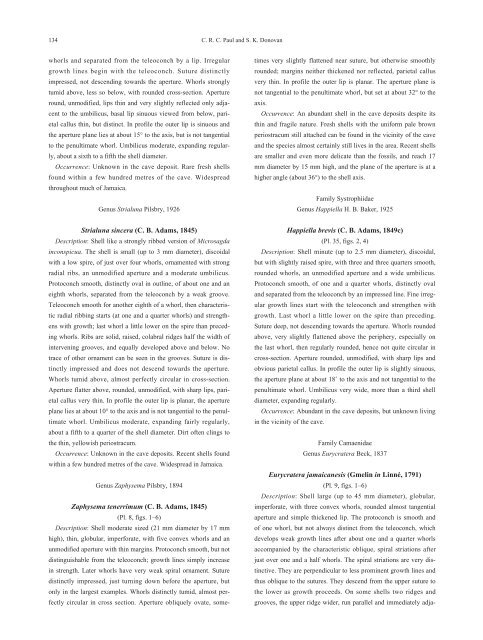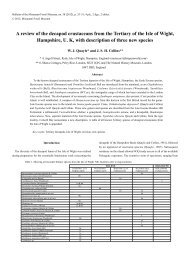Quaternary and Recent land snails (Mollusca: Gastropoda) from ...
Quaternary and Recent land snails (Mollusca: Gastropoda) from ...
Quaternary and Recent land snails (Mollusca: Gastropoda) from ...
Create successful ePaper yourself
Turn your PDF publications into a flip-book with our unique Google optimized e-Paper software.
134<br />
whorls <strong>and</strong> separated <strong>from</strong> the teleoconch by a lip. Irregular<br />
growth lines begin with the teleoconch. Suture distinctly<br />
impressed, not descending towards the aperture. Whorls strongly<br />
tumid above, less so below, with rounded cross-section. Aperture<br />
round, unmodified, lips thin <strong>and</strong> very slightly reflected only adjacent<br />
to the umbilicus, basal lip sinuous viewed <strong>from</strong> below, parietal<br />
callus thin, but distinct. In profile the outer lip is sinuous <strong>and</strong><br />
the aperture plane lies at about 15° to the axis, but is not tangential<br />
to the penultimate whorl. Umbilicus moderate, exp<strong>and</strong>ing regularly,<br />
about a sixth to a fifth the shell diameter.<br />
Occurrence: Unknown in the cave deposit. Rare fresh shells<br />
found within a few hundred metres of the cave. Widespread<br />
throughout much of Jamaica.<br />
Genus Strialuna Pilsbry, 1926<br />
Strialuna sincera (C. B. Adams, 1845)<br />
Description: Shell like a strongly ribbed version of Microsagda<br />
inconspicua. The shell is small (up to 3 mm diameter), discoidal<br />
with a low spire, of just over four whorls, ornamented with strong<br />
radial ribs, an unmodified aperture <strong>and</strong> a moderate umbilicus.<br />
Protoconch smooth, distinctly oval in outline, of about one <strong>and</strong> an<br />
eighth whorls, separated <strong>from</strong> the teleoconch by a weak groove.<br />
Teleoconch smooth for another eighth of a whorl, then characteristic<br />
radial ribbing starts (at one <strong>and</strong> a quarter whorls) <strong>and</strong> strengthens<br />
with growth; last whorl a little lower on the spire than preceding<br />
whorls. Ribs are solid, raised, colabral ridges half the width of<br />
intervening grooves, <strong>and</strong> equally developed above <strong>and</strong> below. No<br />
trace of other ornament can be seen in the grooves. Suture is distinctly<br />
impressed <strong>and</strong> does not descend towards the aperture.<br />
Whorls tumid above, almost perfectly circular in cross-section.<br />
Aperture flatter above, rounded, unmodified, with sharp lips, parietal<br />
callus very thin. In profile the outer lip is planar, the aperture<br />
plane lies at about 10° to the axis <strong>and</strong> is not tangential to the penultimate<br />
whorl. Umbilicus moderate, exp<strong>and</strong>ing fairly regularly,<br />
about a fifth to a quarter of the shell diameter. Dirt often clings to<br />
the thin, yellowish periostracum.<br />
Occurrence: Unknown in the cave deposits. <strong>Recent</strong> shells found<br />
within a few hundred metres of the cave. Widespread in Jamaica.<br />
Genus Zaphysema Pilsbry, 1894<br />
Zaphysema tenerrimum (C. B. Adams, 1845)<br />
(Pl. 8, figs. 1–6)<br />
Description: Shell moderate sized (21 mm diameter by 17 mm<br />
high), thin, globular, imperforate, with five convex whorls <strong>and</strong> an<br />
unmodified aperture with thin margins. Protoconch smooth, but not<br />
distinguishable <strong>from</strong> the teleoconch; growth lines simply increase<br />
in strength. Later whorls have very weak spiral ornament. Suture<br />
distinctly impressed, just turning down before the aperture, but<br />
only in the largest examples. Whorls distinctly tumid, almost perfectly<br />
circular in cross section. Aperture obliquely ovate, some-<br />
C. R. C. Paul <strong>and</strong> S. K. Donovan<br />
times very slightly flattened near suture, but otherwise smoothly<br />
rounded; margins neither thickened nor reflected, parietal callus<br />
very thin. In profile the outer lip is planar. The aperture plane is<br />
not tangential to the penultimate whorl, but set at about 32° to the<br />
axis.<br />
Occurrence: An abundant shell in the cave deposits despite its<br />
thin <strong>and</strong> fragile nature. Fresh shells with the uniform pale brown<br />
periostracum still attached can be found in the vicinity of the cave<br />
<strong>and</strong> the species almost certainly still lives in the area. <strong>Recent</strong> shells<br />
are smaller <strong>and</strong> even more delicate than the fossils, <strong>and</strong> reach 17<br />
mm diameter by 15 mm high, <strong>and</strong> the plane of the aperture is at a<br />
higher angle (about 36°) to the shell axis.<br />
Family Systrophiidae<br />
Genus Happiella H. B. Baker, 1925<br />
Happiella brevis (C. B. Adams, 1849c)<br />
(Pl. 35, figs. 2, 4)<br />
Description: Shell minute (up to 2.5 mm diameter), discoidal,<br />
but with slightly raised spire, with three <strong>and</strong> three quarters smooth,<br />
rounded whorls, an unmodified aperture <strong>and</strong> a wide umbilicus.<br />
Protoconch smooth, of one <strong>and</strong> a quarter whorls, distinctly oval<br />
<strong>and</strong> separated <strong>from</strong> the teleoconch by an impressed line. Fine irregular<br />
growth lines start with the teleoconch <strong>and</strong> strengthen with<br />
growth. Last whorl a little lower on the spire than preceding.<br />
Suture deep, not descending towards the aperture. Whorls rounded<br />
above, very slightly flattened above the periphery, especially on<br />
the last whorl, then regularly rounded, hence not quite circular in<br />
cross-section. Aperture rounded, unmodified, with sharp lips <strong>and</strong><br />
obvious parietal callus. In profile the outer lip is slightly sinuous,<br />
the aperture plane at about 18˚ to the axis <strong>and</strong> not tangential to the<br />
penultimate whorl. Umbilicus very wide, more than a third shell<br />
diameter, exp<strong>and</strong>ing regularly.<br />
Occurrence: Abundant in the cave deposits, but unknown living<br />
in the vicinity of the cave.<br />
Family Camaenidae<br />
Genus Eurycratera Beck, 1837<br />
Eurycratera jamaicanesis (Gmelin in Linné, 1791)<br />
(Pl. 9, figs. 1–6)<br />
Description: Shell large (up to 45 mm diameter), globular,<br />
imperforate, with three convex whorls, rounded almost tangential<br />
aperture <strong>and</strong> simple thickened lip. The protoconch is smooth <strong>and</strong><br />
of one whorl, but not always distinct <strong>from</strong> the teleoconch, which<br />
develops weak growth lines after about one <strong>and</strong> a quarter whorls<br />
accompanied by the characteristic oblique, spiral striations after<br />
just over one <strong>and</strong> a half whorls. The spiral striations are very distinctive.<br />
They are perpendicular to less prominent growth lines <strong>and</strong><br />
thus oblique to the sutures. They descend <strong>from</strong> the upper suture to<br />
the lower as growth proceeds. On some shells two ridges <strong>and</strong><br />
grooves, the upper ridge wider, run parallel <strong>and</strong> immediately adja-





